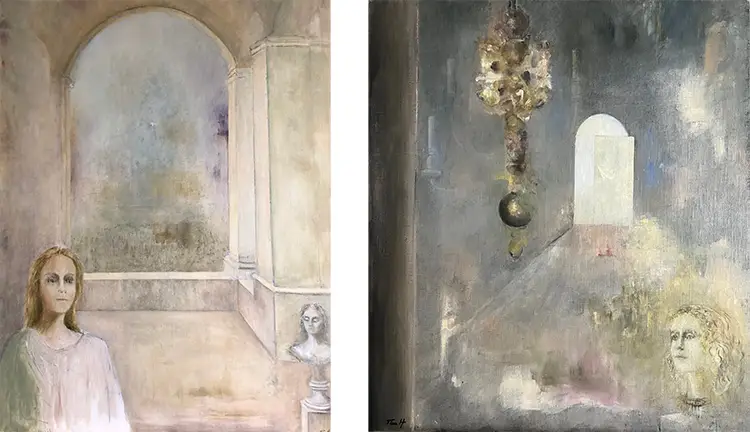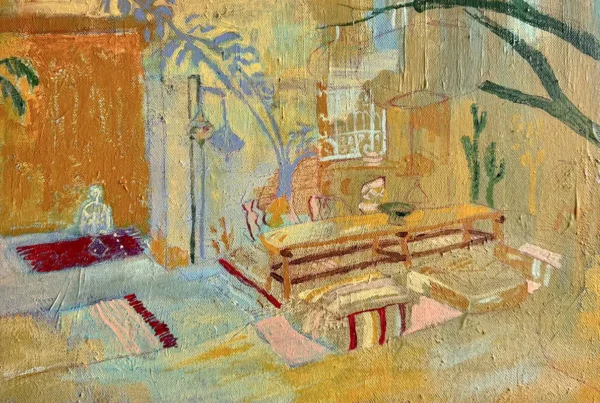“I explore the tension between the imaginary and the concrete, between dream and reality.”
Whispers of Influence: A Life Etched in Oil and Memory
TinaH, the artistic moniker of Swedish painter Tina Hellblom-Thibblin, carves a unique space in contemporary visual art through oil paintings that seem to hum with quiet introspection. Working primarily on linen canvas, her practice merges classical techniques with atmospheric, dreamlike ambiguity. Armed with a Ph.D. in art theory and pedagogy from Uppsala University, she blends intellectual depth with a lyrical, often poetic visual language. Her creative evolution has unfolded across borders, influenced heavily by formative travels in Italy and France. Encounters with ancient mural paintings during these trips left a lasting imprint on her work, particularly in their capacity to convey timelessness and psychological resonance.
Her international reputation continues to grow, with exhibitions spanning Europe, the United States, Dubai, and Beijing. Notable recognition has followed her across continents—TinaH has earned such prestigious accolades as the Botticelli Prize, the Leonardo da Vinci Prize, and both the Velázquez and Goya Prizes. Most recently, her work was honored again with the International Prize Leonardo da Vinci in Milan, while simultaneously being featured in a museum exhibition in Rome. Her paintings have appeared in multiple art publications, reinforcing her presence in the global contemporary art conversation and solidifying her status as a voice of contemplative nuance in today’s fast-paced art landscape.
Her journey began long before awards and international acclaim. At just twelve years old, she discovered a compulsion to translate her inner world into tangible forms. A childhood gift—a paint box from her parents—set her on a lifelong path. Working in oils from the very beginning, she quickly found a medium that mirrored her emotional depth and subtlety of vision. Encouragement from a perceptive high school art teacher nurtured her potential, leading to early recognition through a regional cultural scholarship in Sweden. These early milestones laid the foundation for a career devoted to exploring the gentle intersections of memory, identity, and imagination.
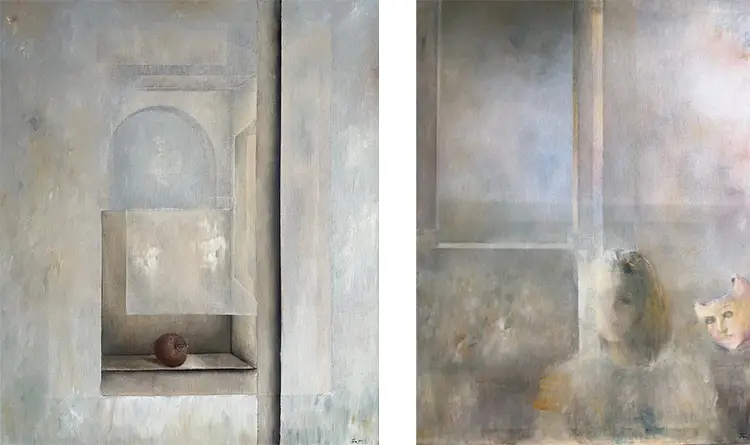
TinaH: Echoes in Dust and Light
TinaH’s style drifts between ethereal surrealism and symbolic realism, grounded by a soft, almost whispering visual tone. Her aesthetic is unmistakable—subdued palettes, ghostly transitions, and dream-imbued compositions that straddle the threshold between presence and absence. Working primarily in ashen greys, chalk whites, and faded ochres, she conjures atmospheres that seem suspended in time. Her brushwork is delicate, designed not to dominate the canvas but to allow forms to emerge like memories returning through fog. This approach results in paintings that never insist, but rather invite—a murmur rather than a proclamation.
At the heart of her visual universe lie recurring architectural elements—arches, windows, corridors—that function less as structural spaces and more as metaphysical signifiers. These forms echo the classical motifs of Renaissance art, yet within TinaH’s compositions they are softened, almost dissolved, evoking not grandeur but inward passage. They serve as visual invitations to move between states of being—between the real and the imagined, the external and the internal. Her use of these forms has often been likened to the metaphysical cities of Giorgio de Chirico, though TinaH renders them with far more empathy and a hushed gracefulness unique to her voice.
Human figures, frequently female, are central yet enigmatic presences in her work. They often appear partially obscured or faceless, further reinforcing her meditation on identity and psychological fluidity. These figures hover in liminal spaces, evoking neither despair nor exuberance but a still, almost spiritual contemplation. Their anonymity allows viewers to project their own emotional experiences onto the canvas, fostering a shared reverie. Occasionally, symbolic objects—a doll’s head, a classical bust, or a single apple—enter her compositions, their meaning intentionally ambiguous. These artifacts, quietly uncanny in their presence, operate as emotional anchors within an otherwise fluid narrative landscape.
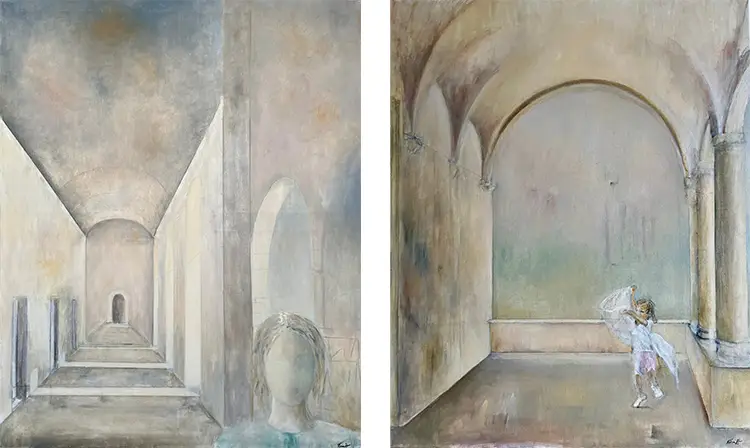
Between Dream and Document: A Vision Beyond the Physical
TinaH’s thematic concerns orbit the porous boundary between imagination and reality. Her paintings explore what happens when the solid structures of the external world give way to the suggestive elasticity of dreams. She frequently draws on themes of spontaneity, unfinished identity, and the silent tension between clarity and vagueness. Her works are not meant to be resolved at first glance. Instead, they demand a slow viewing, where the reward lies in the act of contemplation rather than immediate comprehension. Critics have described her canvases as emotive spaces where form dissolves into atmosphere and meaning is delivered through subtle suggestion rather than direct narrative.
This ambiguity is intentional, and it stems from TinaH’s commitment to intuitive expression. She approaches her work as a visual meditation, allowing ideas to surface from beneath conscious thought. Her studio process reflects this sensibility. She employs a unique oil technique developed over years of experimentation, favoring the slow-drying properties of oil paints for their ability to build layers of nuance and depth. The artist enters a deep state of concentration while working—a creative flow state where distractions are minimized and focus sharpens. Even amidst everyday interruptions, she remains tethered to the emotional thread of her work, seamlessly returning to the canvas with a clarity of intent.
Although oil painting is her primary medium, TinaH has explored other forms of expression, including linoleum printmaking and batik. However, she consistently returns to oil paints, drawn by their richness and capacity for subtlety. Acrylics, she found, lacked the pliability and depth she requires to render her specific atmospheric effects. The weight and flexibility of oil allow her to shape her quiet visions with the necessary patience and precision. This commitment to medium is not about resistance to change but about fidelity to the kind of emotional register she seeks to convey—one that is slow, layered, and immersive.
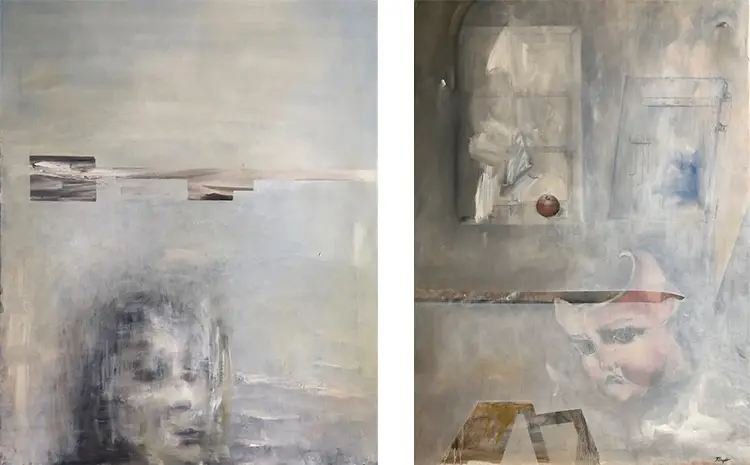
TinaH: A Quiet Force in Symbolist Vision
TinaH’s artistic voice has evolved through a lineage of profound influences. Odilon Redon’s visionary symbolism was an early touchstone for her—a revelation in color and form that showed her how the interior world could be made visible through paint. Redon’s dreamlike approach and use of symbolic imagery resonate deeply with her own sensibility, encouraging her to pursue a path where ambiguity and intuition guide composition. That same poetic logic is evident throughout TinaH’s work, where forms suggest rather than define, and meanings hover just beyond articulation.
Another towering figure in her artistic consciousness is Leonardo da Vinci. His investigations into the human psyche, his dedication to portraying identity, and his scientific attention to detail have all left their imprint on TinaH’s practice. However, she filters these Renaissance ideals through a modern lens, stripping away the spectacle and grounding them in a quiet, psychological intimacy. The Renaissance influence in her work appears less in surface mimicry and more in conceptual inheritance—the sense that every figure, every structure, is a vessel for understanding the self. This deep engagement with classical thought enriches her canvases with both aesthetic and philosophical weight.
Despite her global exhibitions and acclaim, TinaH remains deeply rooted in her inner vision. Her works are not designed to cater to current trends or to offer easily marketable imagery. Instead, they are crafted as meditative experiences—visual poems that speak softly and linger long after viewing. Her consistent recognition, from European museums to international awards, speaks not only to the technical strength of her paintings but also to their emotional resonance. At a time when so much visual culture is immediate and loud, TinaH offers something radical in its restraint: paintings that ask us to slow down, look inward, and listen to the quiet.
